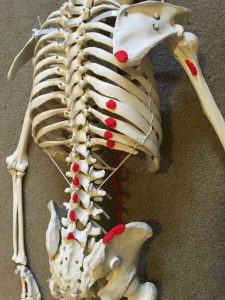Latissimus Dorsi is often thought of as a back/shoulder muscle, but it has a major role in trunk movement. When training the core, it’s essential to know all of the muscle attachments so you can integrate them into your training program.
Having strong core muscles can prevent lower back problems and enhance performance. It’s your job as a personal trainer to know all of these muscles and how to strengthen them according to the individual’s unique needs. Low back issues don’t always stem from a weak core. Sometimes they arise due to strength imbalances.
You can do all the planks you want, but if one side is stronger than the other, it will stay that way until addressed.
Two types of imbalance:
- Between the same muscle on different sides. The right external oblique might be stronger than the left external oblique.
- Between two completely different muscles on the same side. The right external oblique, left internal oblique and left latissimus dorsi all work together to facilitate left trunk rotation. If any one of them is weak, the others will work harder.
Latissimus Dorsi – a core muscle?
Yes! Since everyone knows how to strengthen the rectus abdominis using crunches and planks, let’s focus on trunk rotation which is a more complex motion. During trunk rotation, there are dozens of muscles getting involved to make the motion happen. The strong ones will do most of the work, while the weak ones barely lift a muscle fiber. Ha ha.
Isn’t this true on any team? Some do more work than the rest…
How do you ensure better teamwork within your core muscles?
Knowledge of anatomy and body awareness are essential tools for designing more customized exercise programs for each client. This takes time and attention to the details of muscle movement. Since many people know where their rectus abdominis and obliques are, let’s examine the less-acknowledged core muscle – latissimus dorsi. Most people think they know where it attaches, but are missing a few pieces.
Attachments: Bicipital groove of the humerus bone, inferior border of the scapula, last 3-4 ribs (posterior), thoracolumbar fascia (which attaches into the spinous processes of the lumbar vertebrae), superior/posterior iliac crest. 
Feeling lost in the words? Check out the Play-Doh on Andy the skeleton to see the points. You can also pull out an anatomy book for reference. Explore on the bony landmarks a partner (with their permission of course) and locate the muscle tendons on them.
Why is lat a core muscle?
The attachment into the iliac crest is one of the main reasons the lat likes to help with trunk rotation and lateral side bend! It also helps extend your trunk. Avoid memorizing muscle motions.
When you know the attachments you can always figure out the function of the muscle. “Think like a muscle” is what Andy always says. Then, you can point it out to a client and ask them if they feel it participating in their exercises on both side equally.
Body awareness leads to better cueing and form.
It would be impossible for most people to feel every muscle that participates in trunk rotation, so choosing one muscle like the lat or external oblique to focus on for a set of repetitions is a great way to make it simple, get better focus from the client and exercise more effectively.
Beverly Hosford, MA teaches anatomy and body awareness using a skeleton named Andy, balloons, play-doh, ribbons, guided visualizations, and corrective exercises. She is an instructor, author, and a business coach for fitness professionals. Learn how to help your clients sleep better with in Bev's NFPT Sleep Coach Program and dive deeper into anatomy in her NFPT Fundamentals of Anatomy Course.


